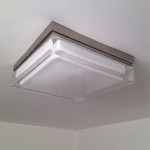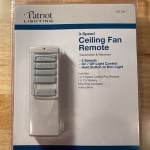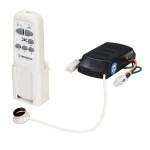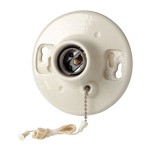Essential Aspects of Ceiling Light Sockets: Understanding the Fundamentals
Ceiling light sockets serve as the crucial interface between your lighting fixtures and the electrical system, enabling a safe and efficient connection. Understanding the essential aspects of these sockets is paramount for effective lighting design, installation, and maintenance. Here's a comprehensive overview of the key elements to consider:
1. Socket Type
The socket type determines the compatibility of the socket with different light bulbs. Common socket types include:
- E26 (Standard Edison screw base): Used for standard household light bulbs, such as incandescent, halogen, LED, and CFL bulbs.
- E27 (European Edison screw base): Similar to E26, but with a slightly wider base, commonly found in Europe and other regions.
- GU10 (Bi-pin connector base): Used in recessed downlights, with two pins that connect to the socket.
- MR16 (Multi-faceted reflector base): Also used in recessed downlights, with two contacts that twist or push into place.
2. Wattage Capacity
The wattage capacity of a socket indicates the maximum wattage of a bulb that can be used safely with that socket. Exceeding the wattage capacity can lead to overheating, electrical hazards, and potential fire risks.
3. Voltage Rating
The voltage rating determines the voltage range within which the socket can operate. Common voltage ratings include 120V (standard household voltage in North America), 220V-240V (common in Europe and other regions), and 277V (used in commercial and industrial settings).
4. Material
The material of the socket, typically either porcelain or plastic, affects its durability, safety, and resistance to heat and corrosion. Porcelain sockets are more durable but also more expensive, while plastic sockets are less expensive but less robust.
5. Installation
Ceiling light sockets require proper installation to ensure safe and reliable operation. This typically involves connecting the socket wires to the electrical supply, securing the socket to the ceiling box using mounting screws, and then attaching the light fixture.
6. Grounding
Grounding is essential for electrical safety. Ceiling light sockets should be connected to the electrical ground to prevent electrical shocks and hazards. This is achieved by connecting the green or bare wire from the socket to the grounding wire in the electrical panel.
7. Maintenance
Regular maintenance is crucial to ensure the longevity and functionality of ceiling light sockets. This includes cleaning the socket contacts with a dry brush or cloth, checking for loose connections, and replacing aging or damaged sockets as needed.
Conclusion
Understanding the essential aspects of ceiling light sockets is crucial for anyone involved in lighting design, installation, or maintenance. By considering socket type, wattage capacity, voltage rating, material, installation, grounding, and maintenance, you can ensure safe, efficient, and aesthetically pleasing lighting solutions.

Ceiling Lamp Spot Light Living Room Rondell 3 Bulb Spots Movable Matt Nickel Gu10 Sockets Dxh 29x14cm Etc Lamps Furniture Technology Household All From One Source

Eaton 660 Watt Porcelain Keyless Ceiling Socket White In The Light Sockets Department At Com

Ceiling Lamp Light Living Room Dining Bedroom 6 Bulbs Metal Black Decorative Leaves Brass E27 Sockets Hxwxd 16 5x54x71cm Etc Lamps Furniture Technology Household All From

How To Replace A Ceiling Light Socket 13 Steps With Pictures

American Imaginations 250 Watt Plastic Keyless Ceiling Socket White In The Light Sockets Department At Com

Ceiling Lamp Holder Base Imitation Ceramic Light Temu

Legrand 250 Watt Plastic Pull Chain Ceiling Socket White In The Light Sockets Department At Com

Ceiling Fan Light Lamp Ventilator Living Room Remote Control Timer 3 Levels Forward And Reverse Metal Silver Glass Opal 2x E27 Sockets Dxh 132x46cm Etc Lamps Furniture Technology Household
E27 Color Silicone Ceiling Rope Cord Pendant Light Sockets

Ceiling Pendant Light Socket 6 Switches Sockets
Related Posts








